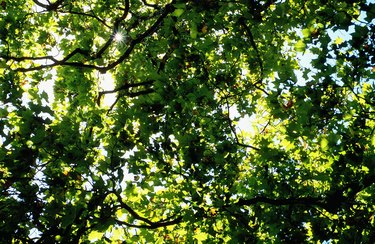
Deciduous trees depend on their leaves for food production. As the weather cools and day length shortens, they shed their leaves, food production stops and the trees go dormant for the winter. All deciduous trees produce flowers that must be pollinated before they can reproduce. Once fertilized, seeds emerge that, under the right circumstances, are capable of producing new trees.
Pollination and Fertilization
Video of the Day
Oak (Quercus sp.) and maple (Acer sp.), both with varieties hardy in U.S. Department of Agriculture plant hardiness zones 3 through 9, are familiar examples of deciduous trees that reproduce by way of seeds. Oaks produce acorns that drop from the trees in late summer, while maples produce winged seeds, called samara, that fall in late summer or early autumn. Pollination of the flowers, which are usually not easily visible on either species, is done by insects, birds or the wind. Pollen from the male anthers transfers to the female stamens, and fertilization takes place inside the small flowers. Acorns are actually embryos produced following fertilization, as are the hard, nut-like portions of the maple seeds as they mature in late summer.
Video of the Day
Seed Distribution
Deciduous trees disperse their seeds in different ways, with the heaviest, like acorns, falling from the tree and most often sprouting where they land if growing conditions are right. Squirrels and large birds, such as crows, often transport the acorns far from the parent tree, and erosion may also move them from one place to another. Maple seeds, however, are light and easily transported by the wind to great distances from the parent trees. Seeds that fall on the ground are also moved by heavy rains and snow melt, as well as birds dropping them in flight.
Germination
For the seed of a deciduous tree to sprout and grow into a new tree, it has to land in a place where the growing conditions are favorable to the species. If an acorn or samara lands on hard, dry ground in an area where there is little rain, the odds are against it germinating and growing. But if it ends up in an area with moist, rich, relatively weed-free soil and plenty of sunlight, its chances of germinating vastly improve. This explains why new trees sprout so readily in the woods where the ground is covered with a thick carpet of damp decaying plant material that helps sustain the growth of new oak or maple seedlings.
Manual Reproduction
Deciduous trees that grow from seed usually bear the characteristics of both parent plants. Growers interested in producing identical trees, or clones, of the tree a seed fell from, propagate them by means of cuttings. This involves manually removing healthy young stems or sections of stems and rooting them before planting them in their permanent locations. This also sometimes produces healthier trees than any that may sprout naturally from seeds, and also gives the grower more control over the outcome.
- Cornell University: Making a New Tree: Reproduction and Cloning
- Newton Ask A Scientist: Oak Tree Reproduction
- Washington State University: Propagating Deciduous and Evergreen Shrubs, Trees, and Vines With Stem Cuttings
- Arbor Day Foundation: Maple, Sugar -- Acer saccharum
- Arbor Day Foundation: Oak, White -- Quercus alba
- University of California Santa Barbara: How Do Conifers, Holly and Acorns (Oaks) Disperse Their Seeds?
- Vanderbilt University: Fruit and Seed Dispersal